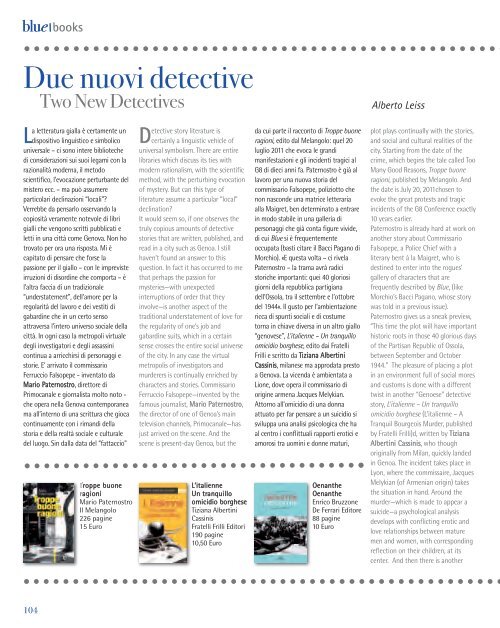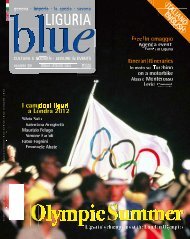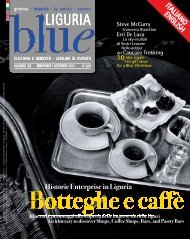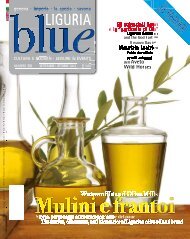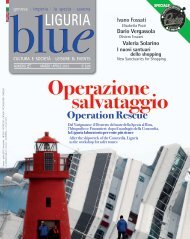Facciamoci sorprendere - Blue Liguria - Sagep
Facciamoci sorprendere - Blue Liguria - Sagep
Facciamoci sorprendere - Blue Liguria - Sagep
You also want an ePaper? Increase the reach of your titles
YUMPU automatically turns print PDFs into web optimized ePapers that Google loves.
lue<br />
Due nuovi detective<br />
Two New Detectives<br />
La letteratura gialla è certamente un<br />
dispositivo linguistico e simbolico<br />
universale – ci sono intere biblioteche<br />
di considerazioni sui suoi legami con la<br />
razionalità moderna, il metodo<br />
scientifico, l’evocazione perturbante del<br />
mistero ecc. – ma può assumere<br />
particolari declinazioni “locali”?<br />
Verrebbe da pensarlo osservando la<br />
copiosità veramente notevole di libri<br />
gialli che vengono scritti pubblicati e<br />
letti in una città come Genova. Non ho<br />
trovato per ora una risposta. Mi è<br />
capitato di pensare che forse la<br />
passione per il giallo – con le impreviste<br />
irruzioni di disordine che comporta – è<br />
l’altra faccia di un tradizionale<br />
“understatement”, dell’amore per la<br />
regolarità del lavoro e dei vestiti di<br />
gabardine che in un certo senso<br />
attraversa l’intero universo sociale della<br />
città. In ogni caso la metropoli virtuale<br />
degli investigatori e degli assassini<br />
continua a arricchirsi di personaggi e<br />
storie. E’ arrivato il commissario<br />
Ferruccio Falsopepe - inventato da<br />
Mario Paternostro, direttore di<br />
Primocanale e giornalista molto noto -<br />
che opera nella Genova contemporanea<br />
ma all’interno di una scrittura che gioca<br />
continuamente con i rimandi della<br />
storia e della realtà sociale e culturale<br />
del luogo. Sin dalla data del “fattaccio”<br />
104<br />
books<br />
Troppe buone<br />
ragioni<br />
Mario Paternostro<br />
Il Melangolo<br />
226 pagine<br />
15 Euro<br />
Detective story literature is<br />
certainly a linguistic vehicle of<br />
universal symbolism. There are entire<br />
libraries which discuss its ties with<br />
modern rationalism, with the scientific<br />
method, with the perturbing evocation<br />
of mystery. But can this type of<br />
literature assume a particular “local”<br />
declination?<br />
It would seem so, if one observes the<br />
truly copious amounts of detective<br />
stories that are written, published, and<br />
read in a city such as Genoa. I still<br />
haven’t found an answer to this<br />
question. In fact it has occurred to me<br />
that perhaps the passion for<br />
mysteries—with unexpected<br />
interruptions of order that they<br />
involve—is another aspect of the<br />
traditional understatement of love for<br />
the regularity of one’s job and<br />
gabardine suits, which in a certain<br />
sense crosses the entire social universe<br />
of the city. In any case the virtual<br />
metropolis of investigators and<br />
murderers is continually enriched by<br />
characters and stories. Commissario<br />
Ferruccio Falsopepe—invented by the<br />
famous journalist, Mario Paternostro,<br />
the director of one of Genoa’s main<br />
television channels, Primocanale—has<br />
just arrived on the scene. And the<br />
scene is present-day Genoa, but the<br />
L’italienne<br />
Un tranquillo<br />
omicidio borghese<br />
Tiziana Albertini<br />
Cassinis<br />
Fratelli Frilli Editori<br />
190 pagine<br />
10,50 Euro<br />
da cui parte il racconto di Troppe buone<br />
ragioni, edito dal Melangolo: quel 20<br />
luglio 2011 che evoca le grandi<br />
manifestazioni e gli incidenti tragici al<br />
G8 di dieci anni fa. Paternostro è già al<br />
lavoro per una nuova storia del<br />
commissario Falsopepe, poliziotto che<br />
non nasconde una matrice letteraria<br />
alla Maigret, ben determinato a entrare<br />
in modo stabile in una galleria di<br />
personaggi che già conta figure vivide,<br />
di cui <strong>Blue</strong> si è frequentemente<br />
occupata (basti citare il Bacci Pagano di<br />
Morchio). «E questa volta – ci rivela<br />
Paternostro – la trama avrà radici<br />
storiche importanti: quei 40 gloriosi<br />
giorni della repubblica partigiana<br />
dell’Ossola, tra il settembre e l’ottobre<br />
del 1944». Il gusto per l‘ambientazione<br />
ricca di spunti sociali e di costume<br />
torna in chiave diversa in un altro giallo<br />
“genovese”, L’italienne – Un tranquillo<br />
omicidio borghese, edito dai Fratelli<br />
Frilli e scritto da Tiziana Albertini<br />
Cassinis, milanese ma approdata presto<br />
a Genova. La vicenda è ambientata a<br />
Lione, dove opera il commissario di<br />
origine armena Jacques Melykian.<br />
Attorno all’omicidio di una donna<br />
attuato per far pensare a un suicidio si<br />
sviluppa una analisi psicologica che ha<br />
al centro i conflittuali rapporti erotici e<br />
amorosi tra uomini e donne maturi,<br />
Oenanthe<br />
Oenanthe<br />
Enrico Bruzzone<br />
De Ferrari Editore<br />
88 pagine<br />
10 Euro<br />
Alberto Leiss<br />
plot plays continually with the stories,<br />
and social and cultural realities of the<br />
city. Starting from the date of the<br />
crime, which begins the tale called Too<br />
Many Good Reasons, Troppe buone<br />
ragioni, published by Melangolo. And<br />
the date is July 20, 2011chosen to<br />
evoke the great protests and tragic<br />
incidents of the G8 Conference exactly<br />
10 years earlier.<br />
Paternostro is already hard at work on<br />
another story about Commissario<br />
Falsopepe, a Police Chief with a<br />
literary bent à la Maigret, who is<br />
destined to enter into the rogues’<br />
gallery of characters that are<br />
frequently described by <strong>Blue</strong>, (like<br />
Morchio’s Bacci Pagano, whose story<br />
was told in a previous issue).<br />
Paternostro gives us a sneak preview,<br />
“This time the plot will have important<br />
historic roots in those 40 glorious days<br />
of the Partisan Republic of Ossola,<br />
between September and October<br />
1944.” The pleasure of placing a plot<br />
in an environment full of social mores<br />
and customs is done with a different<br />
twist in another “Genoese” detective<br />
story, L’italienne – Un tranquillo<br />
omicidio borghese (L’italienne – A<br />
Tranquil Bourgeois Murder, published<br />
by Fratelli Frilli)d, written by Tiziana<br />
Albertini Cassinis, who though<br />
originally from Milan, quickly landed<br />
in Genoa. The incident takes place in<br />
Lyon, where the commissaire, Jacques<br />
Melykian (of Armenian origin) takes<br />
the situation in hand. Around the<br />
murder—which is made to appear a<br />
suicide—a psychological analysis<br />
develops with conflicting erotic and<br />
love relationships between mature<br />
men and women, with corresponding<br />
reflection on their children, at its<br />
center. And then there is another


